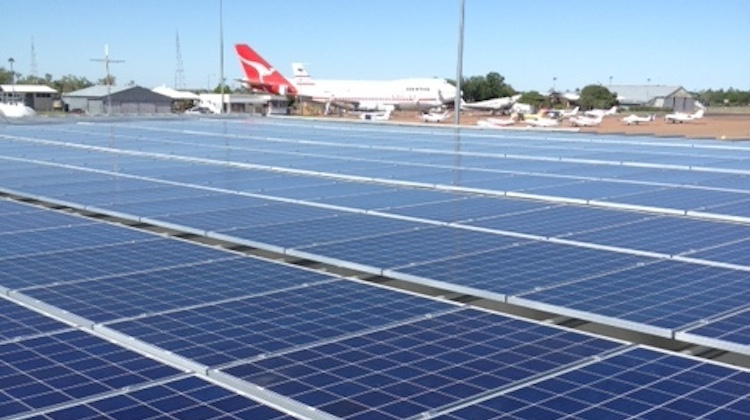
Longreach Airport says the installation of solar panels will supply almost enough energy to cover its daytime power requirements and help cut greenhouse gas emissions
Taking advantage of the abundance of Central West Queensland sunlight and 30-plus degree temperatures, the airport says the 396 solar panels would lower its power bill between $30,000-$40,000 and “more than satisfies the current peak load requirement of 68 kilowatts”.
There will also be 184.9 tonnes less CO2 emissions produced each year.
“Our current annual energy costs from the coal generated grid is between $40,000 to $50,000 but the installation cost of our solar system is into six figures so even with the considerable financial saving it will take a number of years to recoup the cost,” Longreach Airport chief operating officer Kevin Gill said in a statement.
“But to us the real winner is the environment as we are focused on sustainability. At Longreach our new solar installation will provide 95 per cent of our daytime energy requirements and largely replace our use of fossil generated energy.”
Longreach is one of several Australian airports that have introduced solar panels in recent times, with Adelaide Airport’s 4,500-solar panel system on the roof of the short-term car park expected to be completed by April.
Meanwhile, Mount Isa and Townsville Airports, which like Longreach are operated by Queensland Airports Ltd, are also planning to build solar panels.
“At Mount Isa we expect to start on a new solar covered car park in a couple of months, while we are seriously considering solar at Townsville as part of a major redevelopment,” Gill said.
















adammudhen
says:Nice to see, seems like a waste of sunlight to not grab it. I never understand the argument regarding the time taken to recoup the installation cost, surely (as they rightly state) the decision goes beyond the financial implications.
However, not sure why, if the installed panels cover 95% of their requirements, did they not just install the extra 20-odd panels and make it 100%?
TSV
says:Could have been there wasn’t enough physical roof real estate to make it 100%
Adrian P
says:Would the shading of the buildings under the solar panels reduce the payback period due to the reduction in solar gain, hence air conditioning load?
Also using electric vehicles would reduce the fuel tanking costs of diesel.
Corey
says:I’m sure they could of found some pace for a couple of Solar trackers which could of covered the extra 5% of electricity plus more meaning the recoup cost would be quicker feeding back into the grid. It’s nice to see airports trying to reduce their operating costs and also being more environmentally friendly. Now just have to get the local council and the Qantas Founders Museum to install solar!
Tony
says:The real benefit goes to the electricity supplier. First they charge to change the meter, then they charge for daily hire of the meter and then they pay only 6 cents per kWh in Queensland.
Result is that it only pays the user to size panels to meet 90% of the daytime peak rather than export and benefit the supplier. Community loses as a result.
Matt Brewster
says:For unfortunately due to Ergon requirements no power is allowed to be exported back into the electricity network. When the installation is 3 phase such as above the system design has to factor phase imbalance.
Phase imbalance occurs when one phase has more load than another and usually as a result of single phase loads being connected.
When you control the solar output to maintain zero export it means you can only control the zero export margin to the lowest phase load eg. L1 0A, L2 5A, L3 7A. As L1 is the lowest value the system still has to input the L2 & L3. If you didn’t then the system would result in L1 -7A, L2 -5A L3 0A and you would be exporting power into the network from L1 & L2.
Hope this makes sense to all those who voiced their concerns above and good on QAL Longreach Airport for making a difference